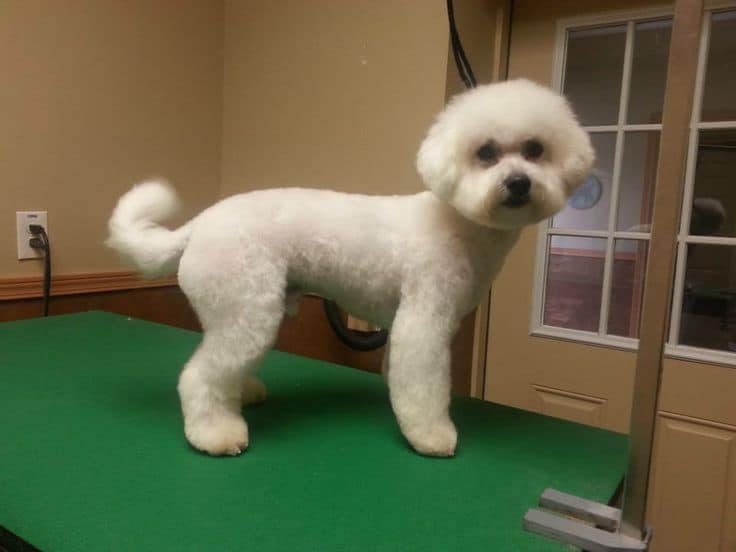With some minor variations, this trim pattern can be adapted to a wide range of purebred and mixed breed dogs. It’s stylish and easy to maintain with moderate care between haircuts. The style lends itself nicely to breed profile trimming and corrective grooming techniques. A knowledgeable groomer in breed profiles and technical techniques can really demonstrate some flair with this trim, if they choose.
The basic pattern is set by the muscle and bone structure of the dog. Clipper work can vary in length from something as short as a No. 10 blade to super-long attach-on combs. Some breeds will have a bit of a crest at the back of the neck where longer fur is commonly left. Other breeds will have a small amount of coat left on their undercarriage or at the brisket to accentuate the depth of chest.
5 areas make up the key points for setting patterns
- the Neck
- the Throat
- the Shoulders
- the Ribs
- the Thighs
- The pattern lines for the front legs start just where the shoulder muscle starts to turn under.
- This is the top of the blending section and ends right at the elbow.
- For the hip, the top portion of the thigh is trimmed to show off a powerful rear.
- You can feel the upper thigh muscle as you run your hand over this region. The coat on the buttocks is shorter than the legs, similar in length to the body.
With the undercarriage, some breeds have their entire rib cage area clipped while others have a slight fringe. This fringe will accentuate the depth of chest.
- If fringe is left the blending line will start just behind the shoulder and run on a diagonal up and over the flank. Opposed to a breed where the undercarriage coat is totally removed. ie., Poodle or Bichon.
- For the rear legs, the pattern line will run on a diagonal from the tuck-up area, over the top of the stifle and toward an area just above the hock. The highest point to this diagonal blending line will start at the flank, with a line running across to the bend of the knee on the back of the rear leg.
- The fur should be long enough in the flank area to control the placement of the tuck-up, the bend of the stifle and the angulation of the rear leg just above the hock.
- If there is fringe left, the shortest section on the underside of the dog, will be placed close to the last two ribs.
- To create depth of chest, slightly longer fur can be left in the brisket area.
When viewed from a few feet away, all pattern and blending lines should be invisible from blending and feathering the shorter coat into the longer hair.
The goal of this trim is to present a cute or stylish trim on a pet, accentuating the proper breed profile whenever possible. Balance, style and symmetry coupled with excellent technical skills all play a role in a pleasing outcome.
Tips for Achieving Smooth Scissor Work
- Use a variety of blades to carve, shape and mold the coat.
- Correctly manipulate your clippers over the body of the pet.
- Hold the shears correctly: thumb and ring finger, stretch out to the “balance point” of the shear. Open and close the shear with only your thumb. Keep the shear at right angles to your hand.
- Scissor with your body. Do not bounce straight or curved shears on the coat as you trim. Bouncing normally stems from someone who is standing still, scissoring from their shoulder. When this happens, the hand has a strong tendency to bounce as the groomer runs the scissors along the coat.
Tips for Achieving Balance and Symmetry
Work with the overall balance of the dog to create a pleasing harmony over the different sections of the body.
- Thinning shears can be your best friend for blending and eliminating minor rough spots in your work.
- When using thinning shears for top thinning, you will bounce your hand slightly each time you close the shear. This small movement will clear the hair just enough so you don’t re-cut already trimmed fur.
- To make sure pattern lines are set at the same level from side to side, stand behind the dog once the pattern line is set and make pointer fingers with each hand. Place your index pointer finger at the pattern point on either side of the dog. Imagine an invisible line through the dog, connecting the tips of your fingers.
- When viewed from the front or rear, front and back legs should be straight falling from the widest sections of the shoulder and hip areas.
Tips on Accentuating the Breed Profile
- Study the individual breed standard found in the AKC Complete Dog Book.
- Watch and review AKC conformation dog shows for the latest styles and trends for purebred dogs.
- Study published material on structure and movement.
- Attend pet grooming shows and competitions.
- Watch highly accomplished stylists as they compete on dogs at grooming competitions.
- Work closely with a breeder or handler.
- Apply fundamental rules of desirable structure to mixed breeds or purebreds that are put into trims. These rules lend themselves to basic body styles of the dog.

